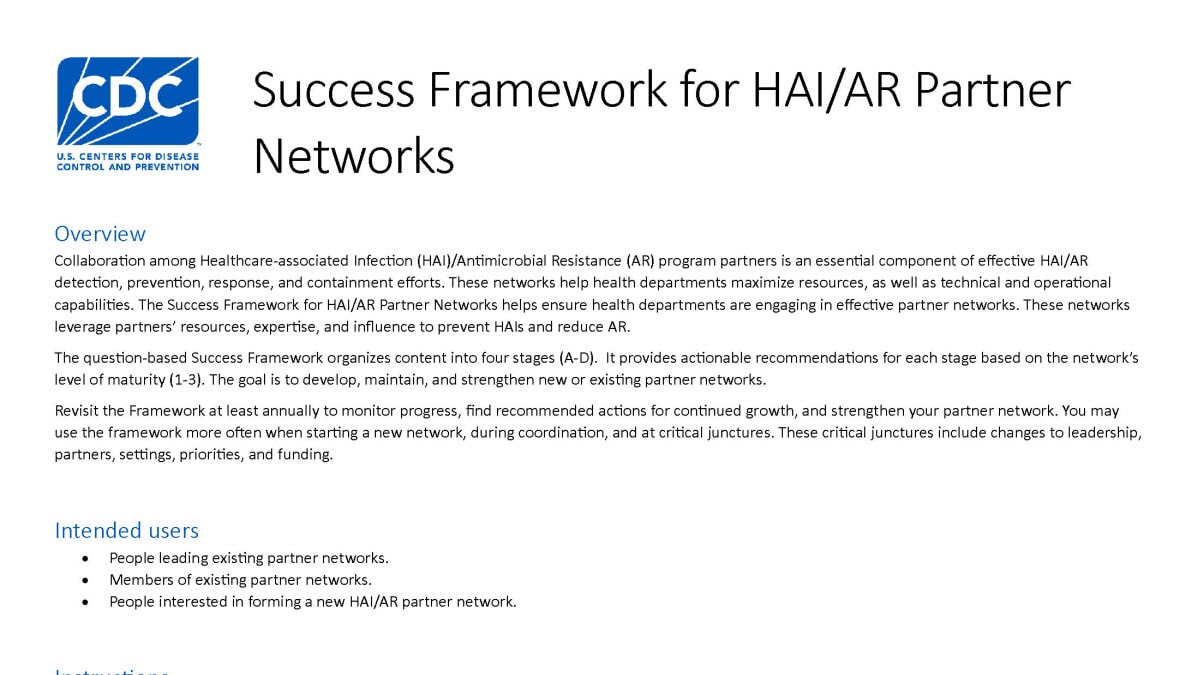Key points
- Partner networks including Healthcare-Associated Infections (HAI)/Antimicrobial Resistance (AR) Program Advisory Committees, collaboratives, academics, healthcare organizations and professional societies help health departments maximize impact. They align roles, responsibilities and capabilities to prevent HAIs and reduce AR.
- Use the Success Framework for HAI/AR Partner Networks to develop, maintain and strengthen new or existing partner networks.
Overview
The Success Framework is a question-based guide designed to help health department HAI/AR programs:
- Engage new partner networks and leverage resources to prevent HAIs and reduce AR.
- Assess the progress, strengths and areas for improvement within existing partner networks.
- Make actionable plans for building, strengthening, sustaining and evolving partner networks.
CDC collaboratively developed and tested the Framework with health departments.1 Use it as a guide for improving and sustaining existing or evolving networks, or as a roadmap for developing new partner networks.
When to use
HAI/AR Programs can use and revisit their Framework as often as they'd like. However, CDC recommends reviewing (and refreshing, as needed) at least annually.
Intended users
- People leading state-level partner networks.
- Members of partner networks.
- People interested in forming a HAI/AR partner network.
Example partners
- State and local health departments.
- State, regional, public health, academic, or commercial laboratories.
- Academic institutions.
- Hospital and healthcare associations.
- Professional organizations.
- Quality improvement organizations.
- State health officials.
Example partner networks
- State and local health department connections.
- HAI/AR Program Advisory Committee.
- Topic-, partner-, or setting-specific collaboratives (e.g., long-term care, rural).
- HAI/AR Program, hospital association, healthcare association, and quality improvement organization coordination.
Steps to take
- Download the Partner Network Framework.
- Determine which partner networks (two or more members, including yourself) you would like to develop or assess.
- Use the Framework as a roadmap (if developing) or a tune-up guide (if assessing).
- Use the Framework as a roadmap (if developing) or a tune-up guide (if assessing).
- Convene members of the network to complete the Framework.
- Use the tool to assess and discuss with your partners where you are now (your 'level' or 'maturity') and where you want to focus your next steps (areas of partnership activities A through D) in the partner network.
- With your partners, reflect, discuss and answer a stage’s guiding questions.
- Go in sequential order (i.e., A through D) or pick stage(s) that resonate with your network’s needs and gaps.
- As you answer questions, consider your gaps and strengths in the context of key elements of successful partner networks.
- With your partners, reflect, discuss and answer a stage’s guiding questions.
- With your partners, review the recommended actions and decide which ones support your network's improvement needs. Determine the additional information, tools or materials that may help your partner network take these actions.
- Your network should be able to demonstrate how it performs all recommended actions in a level before advancing to the next.
- Unless specified otherwise, all entities in the partner network should complete the recommended actions.
- Level 3 actions are the optimal level of maturity. Partner networks who are at a level 3 are encouraged to review and reflect on the lower maturity levels.
- Your network should be able to demonstrate how it performs all recommended actions in a level before advancing to the next.
- Revisit the Framework at least annually to monitor progress, find recommended actions for growth and strengthen your partner network.
Download the Success Framework for HAI/AR Partner Networks
CDC support
CDC can help you decide which partners to include, convene network members and share resources on partner landscape and strengths assessments. Email the team for assistance.
Successful networks
After consulting with health departments around the country, CDC learned that successful and sustainable partner networks succeed in seven key elements.1
Elements to prioritize
1. Leadership, strategy and structure
Networks that excel in this element develop shared goals and activities with defined roles and responsibilities. They do this through an established operating model, such as charters, advisory or steering committee structures and meeting structures. This model includes leadership, accountability and approaches for coordination and decision-making.
2. Expertise and resources
Networks that excel in this element have a mix of expertise and capabilities needed to address shared goals; they analyze and coordinate funding to address gaps and opportunities in funding or resources. By doing so, they maximize capabilities, reach and effectiveness.
3. Communications
Effective networks communicate goals, activities, and progress to coordinate efforts, share knowledge and influence future efforts and people. By doing so, they strengthen trust and increase coordination, efficiency and impact.
4. Policies
Effective networks track policy development and its impact on activities, allowing them to anticipate and adapt to influences.
5. Implementation
Networks that excel in this element implement planned activities according to partner strengths, shared goals and defined roles and responsibilities. By doing so, they ensure activities are purposeful and align with their goals and objectives.
6. Monitoring and evaluation
Networks that excel in this element monitor progress towards shared goals and identify areas for improvement. By doing so, they support the partner network's evidence base, effectiveness and evolution.
7. Innovation and adaptability
Effective networks evolve their structure and adjust priorities, goals and resources based on changing circumstances and lessons learned. By doing so, they advance the partner network's relevance, maturity and sustainability.
- Joshi, C., Mothershed, E., Vance, W., McLees, A., Paek, M., Coteau, A. de, ... Meka, S. (2020). Core Elements of a State HAI/AR Program With Emphasis on Partnership Networks. Infection Control & Hospital Epidemiology, 41(S1), s181–s182. doi:10.1017/ice.2020.716

